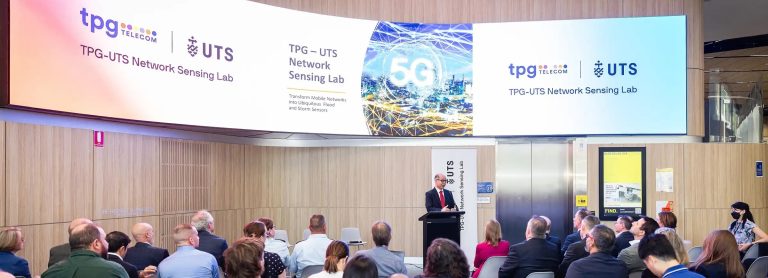Sensing for Disasters Solutions

CIN and NSSN representatives at the 2023 Regional Connectivity Symposium in Lismore
By harnessing advancements in robotics, artificial intelligence (AI), and the Internet of Things (IoT), the CIN’s suite of Sensing projects will improve disaster preparedness and response capabilities, particularly in regions prone to extreme weather events.
These projects will drive real-time disaster monitoring solutions, addressing the escalating impact of climate-induced events such as floods and bushfires.
The Problem: Addressing Agility and Precision Gaps in Disaster Response
While technologies such as satellite imaging and weather radars provide valuable data, they often fall when rapid response and precision are required. This was demonstrated during crises such as the Lismore floods, where limitations in current systems contributed to unpreparedness and increased vulnerability for affected communities.
Market Gaps: Insufficient Real-Time Disaster Sensing
Current disaster management systems face several critical challenges:
- Limited real-time updates: Existing solutions often lack timely insights necessary for responsive action.
- Inadequate coverage: Many systems do not offer comprehensive, continuous disaster monitoring.
- Weak integration with emergency services: Seamless interaction with first responders remains limited.
Our Solutions: Advancing accurate Sensing for Real-Time Disaster Management
The Sensing for Disasters Solutions addresses these gaps by developing sophisticated sensing technologies that include:
- Robotics and AI: Enabling automated, precise disaster monitoring.
- Low-Cost Radar and IoT: Facilitating wide-scale data collection and real-time transmission.
- Signal Processing Techniques: Improving accuracy and speed in disaster predictions
Our Sensing for Disasters projects
1. Integrated Sensing and Communication Technology for Disaster Monitoring
Professor Jinhong Yuan – University of New South Wales
Duration: 12 months
2. Advanced AI-Enhanced Geospatial Sensing for Disaster Management
Lead: Dr. Wanchun Liu – University of Sydney
Collaborators: University of Technology Sydney and Pivotel Satellite
Duration: 12 months
3. A Novel Real-Time and Accurate Wireless Rain Gauge
Lead: Dr. Kai Wu – University of Technology Sydney
Funding: $149,092
Duration: 12 months
Project leads:
Project 1: Professor Jinhong Yuan – University of New South Wales
Project 2: Dr Wanchun Liu – University of Sydney
Project 3: Dr Kai Wu – University of Technology Sydney
Total funding:
$230,000
Project duration:
12 months
Project status:
In progress
Final presentation:
December 2025
Grants and Awards
December 2023
The Connectivity Innovation Network awarded grant funding
Frequently Asked Questions (FAQ)
The Sensing for Disasters project offers significant benefits for a wide range of stakeholders, particularly:
Emergency Response Agencies – Real-time monitoring enables rapid deployment of resources, improved coordination, and more informed decision-making during disaster events, enhancing the effectiveness of emergency response.
Local Communities in Disaster-Prone Areas – Residents in areas vulnerable to floods, bushfires, and other extreme weather events benefit from early warning systems and more resilient infrastructure, allowing them to better prepare and respond.
Government and Disaster Management Organisations – Real-time sensing data helps these bodies in planning, resource allocation, and policy-making, ensuring proactive disaster preparedness and improved resilience planning.
Healthcare Providers – Continuous monitoring ensures that emergency routes and services remain functional, supporting healthcare providers in delivering critical services even during crises.
Educational Institutions and Researchers – Universities and research institutions can use the project’s findings to advance disaster technology, improving predictive models and developing innovative solutions for disaster resilience.
- Utility and Infrastructure Companies – This technology can provide early warnings of potential impacts on infrastructure, allowing for preventative measures to protect essential services like power and water.
Overall, the Sensing for Disasters project has the potential to transform how communities, responders, and policymakers prepare for and respond to natural disasters, building a safer and more resilient future.
Subscribe to our mailing list and follow us on LinkedIn for the latest updates.
Find out more
To stay updated on this exciting project, subscribe to our mailing list and follow us on LinkedIn.
For enquiries:
- Media Enquiries: communications@connectivityinnovationnetwork.com
- General Enquiries: admin@connectivityinnovationnetwork.com



